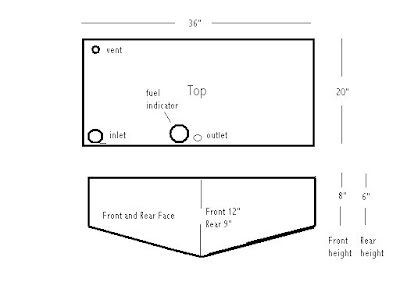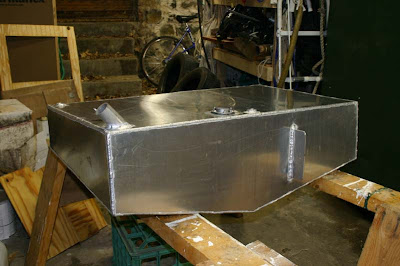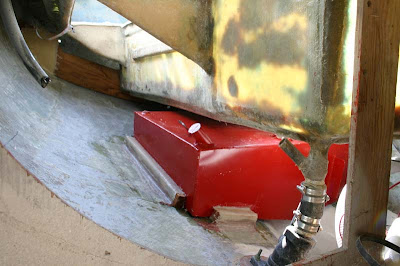
The first snow of the year is falling so today seems like a good day to stay indoors and blog a bit about the tankage on my boat for which I am just a little bit proud.
The original water tank in the Triton was a 28 gallon fiberglass tank under the V-berth. After 40 years since the boat was built I really wasn't too keen about drinking out of this tank. On my last cruise I kept two 6 gallon water jugs in the bilge and other ten gallon jugs scattered around. It was sufficient, and it made it easy to dinghy up to wherever I could find water, but I really wanted real water tanks in the boat with sufficient capacity to go a few weeks between fill-ups. 20 gallons were enough to go about a week by myself with a few days reserve in case I was stuck in bad weather. Traveling with another person would have meant stopping for water too often for the type of cruising I like doing - finding a quiet, remote spot and just sitting and exploring.
I decided to build a mockup for a larger tank in the V-berth area. I know of one Triton with a 40 gallon water tank that has cruised quite extensively and that seemed like the maximum amount of weight I wanted that far forward. My basic plan was to put the tank in the same spot but make it taller, bringing it up to the height of the V-berth area. In theory, this works well. The problem came when I tried to get the tank out so that I could go to the welding shop and have them make me a real tank. The mockup would not fit through the mast supports that define the entrance to the V-berth 'room'. Thinking that maybe Carl Alberg knew what he was doing when he specified the 28 gallon tank I decided to simply copy the original in stainless steel.
I also had the deep bilge area that seemed to be going to waste. I originally thought of putting a fuel tank in there but I ran into some safety/regulatory problems. My engine burns gasoline. Even a small leak will give off explosive vapors so the US Coast Guard requires all gas tanks to have all fittings mounted on the topmost surface of the tank to reduce the chances of a fitting failure turning the boat into a bomb. Lowering the tank height sufficiently to allow room for those fittings really cut into the total capacity of the tank. Instead, I decided to use the space for an additional water tank. This tank adds another 22 gallons of potable water capacity giving me 50 gallons of drinking water which I can still supplement with gallon jugs or whatever if I really needed more. I think for a small boat like the Triton this is about as good as it is going to get
The original Triton fuel tank is located in the starboard cockpit locker. While easy from the manufacturer's standpoint, it really cuts into my available cockpit storage area and having all the weight on the side is less than ideal. I decided to remove the original tank and replace it with a tank that sits directly under the cockpit sole in an otherwise unused space. As an additional benefit the new tank holds 27 gallons of fuel which is about 5 gallons more than the original tank. Not much perhaps but that is also a 23% increase in motoring range and every little bit helps on a small boat like this.
Finally, my boat came with a porta-potty that was plumbed to be pumped out via a deck mounted fitting. The porta-potti was removed in the first week that I owned the boat and replaced with a bucket for the first cruise. For cruising alone I could get away with this. Cruising with other civilized persons was going to require something a bit better and less smelly. Just forward of the head, under the V-berth, I installed a 16 gallon holding tank. I don't plan on using the tank much but hopefully it means I will never have to haul a full five gallon bucket of poop out through the cabin, up the stairs, across the cockpit and over the side ever again.
Here are some pictures:
The V-berth water tank.

The waste holding tank.

The bilge water tank in position

A drawing and a few pictures of the fuel tank. It isn't shown in this drawing but the tank has two baffles inside to keep the fuel from sloshing too much. With a low, wide, tank like this sloshing could be a problem.



This is looking down at the fuel tank through the cockpit access hatch. This access hatch is one of the best things I have done for my Triton. It makes working on the propeller shaft seal and the aft parts of the engine dead easy.

This is looking down into the cockpit locker. The tank sticks into the locker space by a few inches making access to the connections easy and adding capacity. Extending the tanks further out adds less and less capacity and I just found this size to be the best compromise for me.

And here is the tank looking if from the galley area. An identical tank was built for another 'early model' Triton and it fit just like this one. I suspect that the tank dimensions will fit most Tritons out there but I would still strongly recommend building a mockup just to be sure. Part of the design limits are the requirements to slip the tank into position from the galley area. It is a snug fit but seems to work okay. I have't finished with the tank installation either. I still need straps or tie downs to kee the tank down as well as some sanding and painting to clean it up.

If you have any questions feel free to ask.












